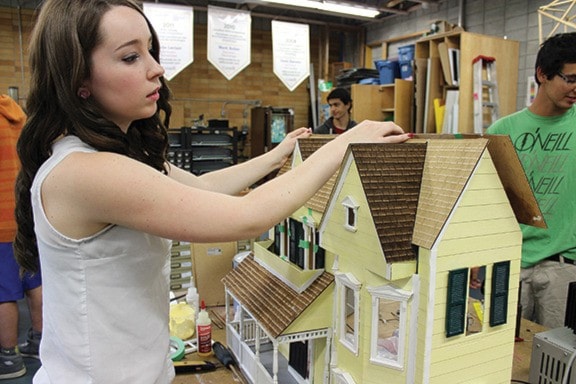A jet engine, a scale model of a house and a 3D printer are just a few of many projects to come out of G.P. Vanier Secondary School this year.
Students in MEEP 12, (math, English, engineering and physics), last week put the finishing touches on the self-directed projects they designed and built this term in Steve Claassen's engineering 12 class.
Student Sandra Puga — one of three girls in the class — plans to become an architect, so she chose to create a scale model of a house. Using 3D modelling software, she created parts like the windows, shutters, poles and doors, then printed those models out using one of the classroom's 3D printers.
(A 3D printer creates real objects from digital 3D models. Claassen's classroom has three printers and these printers use heated plastic to make the object, though other 3D printers can use other materials, too.)
Puga also used software to create gradients on parts of her model house, like shading on the roof, and used a laser engraver to create textures, like indents in the siding on the house.
"It's the most incredible class I think I've ever been in," says Puga. "Being able to use state-of-the-art equipment, it makes such a difference. When you hit print on a 3D model and it comes out like a real thing — it's mind blowing. The first time I did it I was like, 'Whoa, this is actually what I drew.' It's just crazy."
Meanwhile, student Mac Quinn, who is interested in mechanical engineering, decided to design and build his own 3D printer, using mostly 'do-it-yourself products' and doing some research online.
"But, mostly I was working on my own ideas because I didn't really want to copy something if it was for a final project," says Quinn, who has been in Claassen's classroom since Grade 8.
"I found that (3D printers are) extremely useful … because you can design something with a CAD (computer-aided design) program, and then two, three hours later, you can actually see how it functions and works on a small scale, before you create the entire device."
The hands-on aspect of the engineering course is an important one for Quinn.
"It allows us to apply the actual sciences and the math, and it gives us a much better understanding of what we're getting into," he continues. "Of course, whenever you do something it takes three or four times as long as you think it will, but with this you can get a better idea of how to do it."
Caassen compares the importance of engineers being able to physically build what they design to a car.
"You can be the smartest kid at engineering and have the 99.9 per cent — but go design a new car, now you've got to take the whole engine apart to change a spark plug because you designed it to work but it's not practical," he says. "So, it's that practical side that the kids get."
He says many of the 26 students in the MEEP 12 cohort will go on to be engineers, and the entire class has very high grade point averages.
"This is probably my best group ever," he adds, noting part of the reason these students and their projects are so strong is due to the classroom tools they have available to them. "This is my pinnacle of five years of hard work and building up a room. Five years ago there was no laser engraver, there were no 3D printers, there weren't 30 computers in here."
Claassen calls his classroom makerspace, as students, including some from other classes, can come in and use the tools in it to create what they want.
In order to purchase the expensive equipment for his classroom, Claassen supplements funding for the class via a variety of methods.
"I do $1,000 a year in copper. I recycle copper and take it to Vancouver," he says. "I do all the awards for this school and other schools, and banners and signs and T-shirts for many other places, and that money goes back into my program."
Some of the other student projects include a working jet engine, a plasma speaker, lights that go on and off when a bass drum is beat, a sluice box for gold mining, a recliner controlled by a phone and a compressed air T-shirt cannon.
writer@comoxvalleyrecord.com
